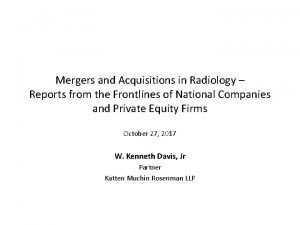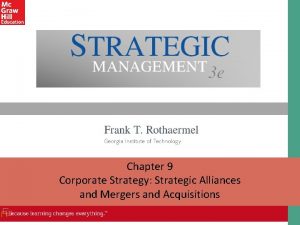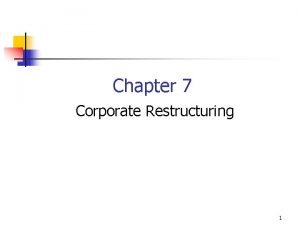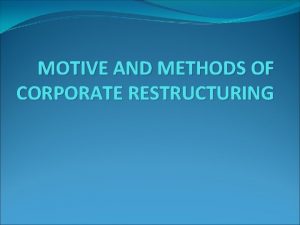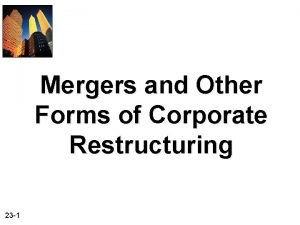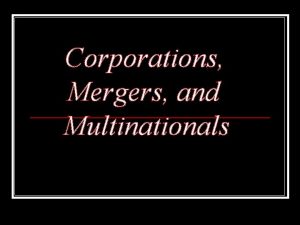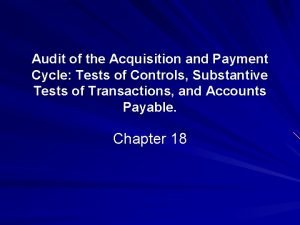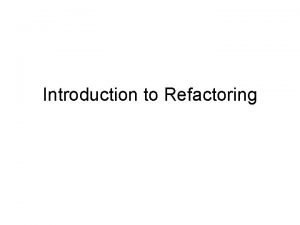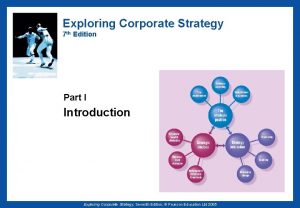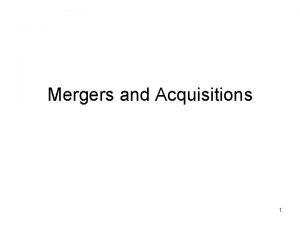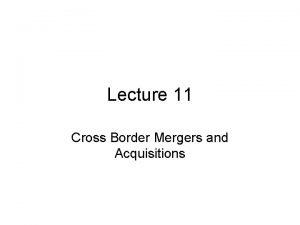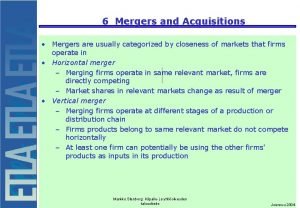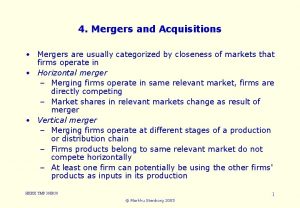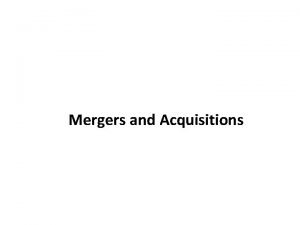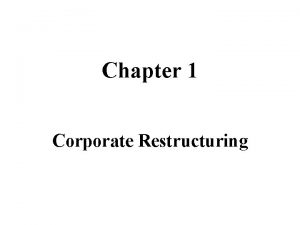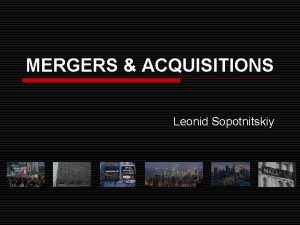Mergers Acquisitions And Corporate Restructuring SECOND EDITION Prasad































- Slides: 31

Mergers, Acquisitions And Corporate Restructuring SECOND EDITION Prasad G. Godbole Copyright Publishing House Pvt. Ltd. rights reserved. Copyright©© 2009 2013 Vikas Prasad Gajanan Godbole. All rights reserved.

Chapter 13 Taxation Aspects of Amalgamation And Demerger

CHAPTER 13 Basic Taxation Issues in Amalgamation and Demerger Amalgamation involves transfer of property (fixed assets, investments, current assets, etc. ) from the amalgamating company (ies) to the amalgamated company. Similarly, in case of demerger there is a transfer of property from the demerged company to the resulting company(ies). Would this transfer attract capital gains tax? If so, the amalgamation or demerger can be so prohibitively expensive that it would become a nonstarter.

CHAPTER 13 Basic Taxation Issues in Amalgamation and Demerger The shareholders of an amalgamating company are issued shares of the amalgamated company in lieu of the shares held by them in the former company. Would this amount to ‘transfer’ as contemplated in the Income Tax Act, 1961, and attract capital gains tax? What will happen, if in addition to the issue of shares of the amalgamated company, cash or bond or the like is paid to the shareholders of the amalgamating company? In case of a demerger, the shareholders of the demerged company are allotted shares in the resulting company. Would this attract capital gains tax?

CHAPTER 13 Basic Taxation Issues in Amalgamation and Demerger In case, an amalgamating company has unabsorbed depreciation or carried forward losses. Would the amalgamated company be eligible for setting them off against its future profits? In case of a demerger, if there are carry forward losses and unabsorbed depreciation relating to the undertaking being demerged, prior to the demerger. Who can set them off against future profits? Is it the demerged company or the resulting company?

Amalgamation u/s 2 (1 B) of the Income Tax Act, 1961

Amalgamation u/s 2 (1 B) of the Income Tax Act, 1961 Pre-conditions to qualify for Amalgamation: 1 All the properties of the amalgamating company, immediately before an amalgamation, should become properties of the amalgamated company by virtue of amalgamation. 2 All the liabilities of the amalgamating company, immediately before an amalgamation, should become liabilities of the amalgamated company by virtue of amalgamation. 3 Shareholders holding not less than three-fourth (in value) of the shares in the amalgamating company (other than the shares already held by the amalgamated company or by its nominees) should become shareholders of the amalgamated by virtue of amalgamation.

Example ABC Limited has a paid-up equity capital of Rs 10 crore consisting of 1 crore shares of Rs 10 each. It has no preference share capital. Twenty per cent of its equity shares are held by XYZ Limited who has a paid-up capital of Rs 50 crore consisting of 5 crore shares of Rs 10 each. It was decided to merge ABC Limited with XYZ Limited and to allot 1 share of XYZ Limited for every 2 shares of ABC Limited held to the shareholders of ABC Limited. As per the above rule, not less than 75 per cent of the shareholders (in value) of the share capital of Rs 8 crore, (i. e. , Rs 10 crore total PUC less Rs 2 crore held by XYZ Limited) i. e. , shareholders holding equity capital worth Rs 6 crore minimum have to become shareholders in XYZ Limited by virtue of (allotment in) amalgamation. However, what would happen if a 100 percent subsidiary is amalgamated with its parent company? How will the above condition get satisfied in this case? It has been clarified by the Central Board of Direct Taxes (CBDT) circular 5 -P dated 09 October, 1967 that such amalgamation shall also qualify as under the definition mentioned earlier.

Transactions not termed as Amalgamations Where the property of the company which merges with the other company is sold to the other company and the merger is the result of such transaction of sale Where the company which merges is wound up in liquidation and the liquidator distributes its property to the other company

Demerger u/s 2 (19 AA) of the Income Tax Act, 1961

Demerger u/s 2 (19 AA) of the Income Tax Act, 1961 Pre-conditions to qualify as Demerger: 1 Both the entities involved should be companies. 2 Conditions of sections 391 to 394 of the Companies Act, 1956 should have been complied with. 3 There must be a transfer of an undertaking to the resulting company. Undertaking essentially implies all assets which taken together as a whole, constitute a business activity and not individual assets which by themselves are not able to run the business activity.

Demerger u/s 2 (19 AA) of the Income Tax Act, 1961 Pre-conditions to qualify as Demerger: 4 All properties belonging to an undertaking should be transferred to the resulting company. 5 The resulting company must take over all the liabilities of the undertaking being transferred. 6 All properties and liabilities are to be transferred at the book value only. . 7 The transfer of the undertaking should be on going concern basis.

Implications in terms of Capital Gains Tax

Transactions which are not treated as transfer of a capital asset in relation to Amalgamation and Demerger and therefore, no capital gains tax is chargeable: 1 Transfer of a capital asset in the scheme of amalgamation, if the amalgamated company is an Indian company [section 47 (vi)]. 2 Transfer of a capital asset in the scheme of demerger, if the resulting company is an Indian company [section 47 (vi b)]. 3 4 Allotment of shares in an amalgamated company in lieu of shares of an amalgamating company if the transfer is in consideration of the shares of the amalgamated company is an Indian company [section 47(vii)]. Any issue of shares by the resulting company, in a scheme of demerger to the shareholders of the demerged company [section 47 (vi d)].

Transactions which are not treated as transfer of a capital asset in relation to Amalgamation and Demerger and therefore, no capital gains tax is chargeable: 5 Transfer of shares in an Indian company held by a foreign company to another foreign company under the scheme of amalgamation of two foreign companies. [section 47 (vi a)] provided: (i) (ii) 6 at least 25 per cent of the share holders of the amalgamating foreign company continue to be the share holders of the amalgamated foreign company such transfer attracts no capital gains tax in the country in which the amalgamating company is incorporated Transfer of shares held in an Indian company by a demerged foreign company to the resulting foreign company. [section 47 (vi c)] provided: (i) (ii) at least 75 per cent of the share holders of the demerged foreign company continue to be the share holders of the resulting foreign company. such transfer attracts no capital gains tax in the country in which the demerged company is incorporated.

Example Mr P had acquired 1000 shares of ABC Limited on 15 November 2001 at a cost of Rs 276 inclusive of brokerage. ABC Limited was merged with XYZ Limited on the appointed date of 1 April 2004. The shareholders of ABC Limited were issued two shares of XYZ Limited for one share of ABC Limited held by them. Allotment happened on 17 October 2004. In June 2006, XYZ Limited launched a buy-back tender offer to acquire 22 per cent of the paid-up equity capital at Rs 210 per share. Mr P tendered his entire shareholding in XYZ Limited. The response to tender offer being poor, XYZ Limited accepted the entire quantity tendered by Mr P. He received the consideration on 7 August 2006. What would be the incidence of capital gains tax and at what stage? (i) There will be no incidence of capital gains tax when shares of XYZ Limited are allotted to Mr P in lieu of his holding in ABC Limited. (ii) Cost to Mr P of shares of XYZ Limited = (Cost of shares of ABC / No of shares of XYZ) = Rs (1000 x 276)/(2000) per share of XYZ Limited = Rs 138 per share of XYZ limited (iii) Though the shares of XYZ Limited were held by Mr P for less than twelve months from the date of their allotment, by virtue of his holding of ABC Limited shares, he would be liable to pay long-term capital gains tax if not otherwise exempt under any other provision of the Act.

(iv) With effect from AY 2005– 06, any income by way of long- term capital gains from sale or transfer of equity shares is exempt from tax provided the sale was effected through a recognized stock exchange, and the securities transaction tax (STT) was paid on such sale. However, in Mr P’s case, he has transferred his shares in a buy-back scheme where STT is not applicable. Hence, Mr P will be liable to pay long-term capital gains tax at 20 per cent with indexation or at 10 per cent without indexation. * No of shares of XYZ Limited x Buy-back price = 2000 x 210 ** Indexed Cost of Acquisition of 2000 shares of XYZ Limited = Rs 138 x 2000 x(Index for PY 06– 07/Index for PY 04– 05) = Rs 276000 x (519/480) *** Non Indexed Capital Gains = Rs (420000– 276000) = Rs 144000 Thus, in the above illustration, the capital gains tax liability (excluding surcharge and education cess) would be Rs 24, 315. However Mr P would have a choice of paying capital gains tax of Rs 14, 400 at a flat rate of 10 per cent on non-indexed capital gains, which he would obviously choose in this case.

Other Issues in Terms of Capital Gains Tax

The following transactions relating to some other forms of capital structuring are not treated as transfer of a capital asset, and therefore, no capital gains tax is chargeable: v Transfer of a capital asset by a company to its 100 percent subsidiary [section 47(iv)]. v Transfer of a capital asset by a 100 percent subsidiary company to its parent company [section 47 (v)]. In both the cases of transfer between the parent and the 100 percent subsidiary company, the transferee company must be an Indian company.

Implications in Terms of Carry Forward and Set Off of Losses and Unabsorbed Depreciation

Section 72 and 72 A A When a loss (including unabsorbed depreciation) under the head ‘profits and gains of business or profession’ cannot be set off against the income under the same head or under a different head in the same year, because of the absence or inadequacy of income of the same year, it may be carried forward and set off against the profits of any business in the subsequent years. While the loss can be carried forward only for eight assessment years subsequent to the assessment year in which it was incurred, unabsorbed depreciation can be carried forward indefinitely. However, one main condition of such carry forward and set off is that the loss can be carried forward and set off by the same assessee. Sec. 72

Section 72 and 72 A B In order to resolve this problem, section 72 A provides certain exceptions to the rule that the loss can be carried forward and set off by the same assessee. Two of these exceptions are amalgamations and demergers. The accumulated loss and unabsorbed depreciation of an amalgamating company are deemed to be the carried forward loss/depreciation of the amalgamated company for the previous year in which amalgamation had taken place

Pre-conditions to Carried Forward Loss/Depreciation of the Amalgamated Company: i The amalgamating company has to be an industrial undertaking, ship or a hotel or a banking company amalgamating with SBI or a subsidiary of SBI. iv The amalgamated company continues to hold at least threefourth of the book value of the amalgamating company’s fixed assets for five years from the date of amalgamation. ii The amalgamating company has been engaged in the business in which the accumulated loss or unabsorbed depreciation has occurred at least for three years. v The amalgamated company continues the business of the amalgamating company at least for a period of five years from the date of amalgamation. iii The amalgamating company has held continuously as on the date of amalgamation, at least three-fourth of the book value of the fixed assets held by it two years prior to the date of amalgamation. vi The amalgamated company achieves at least 50 percent capacity utilization before the end of the fourth year and continues the level achieved till the end of the fifth year.

Section 72 and 72 A C In case of demerger also, section 72 A allows/requires the resulting company to carry forward and claim the accumulated loss and unabsorbed depreciation to the following extent: (i) In case the loss/depreciation is directly related to the undertaking transferred to the resulting company, then the whole of such loss/depreciation has to be carried forward (ii) In case the loss/depreciation is common to the retained and transferred undertakings, then the loss apportioned on the basis of book value of assets transferred and retained, has to be carried forward Sec. 72 A

Reverse Mergers Where a holding company merges with the subsidiary or investee company Where a profit-making company is merged with the loss making company This second concept of reverse merger is relevant from income tax point of view. In case of a reverse merger, since profit-making company is merged with the lossmaking one, the surviving entity is the erstwhile loss-making company. With this, the condition that the same assessee has to carry forward and set off the loss is satisfied, and the merged entity can, in future, set off the past losses against the future combined profits.

CERTAIN VEXATIOUS TAX ISSUES RELATING TO M&A

CHAPTER 13 Stepping up the Cost Basis In some countries, like the US, the goodwill paid over the book value of net assets (i. e. , assets minus liabilities) taken over is, upon the merger of the target with the acquirer, allowed to be used for increasing the book value of the target’s depreciable assets. It thereby, steps up their cost basis for tax purposes. Thus, the goodwill gets amortized through enhanced value of the depreciable assets. In India, however, the same is not possible.

CHAPTER 13 Goodwill Ø In some countries, such as the US and Netherlands, the goodwill itself is allowed to be amortized over a specified period for the tax purposes. Ø In India, such ‘acquired goodwill’ is not depreciable for the tax purposes.

CHAPTER 13 Share Swap during Acquisition v While section 47 (vii) provides for tax exemption in of a share swap during the course of amalgamation, no such benefit is available for acquisitions made by the share swaps wherein there is no cash or other consideration flowing to the target company’s shareholders. v This poses difficulties to many of the Indian corporate who may not be so cash rich as compared to their foreign competitors.

The level playing field is also missing in sections 47 (vi a) and 47 (vi c). While these sections provide exemptions in case of amalgamations or demergers of foreign companies in respect of Indian shares held by them, there is no such exemption available to amalgamations or demergers of Indian companies which hold shares in the foreign companies. Given that many Indian companies are acquiring companies abroad. CHAPTER 13 Level Playing Field to Indian Companies vis-à-vis Foreign Companies

CHAPTER 13 Carry Forward of Loss and Set Off by Unlisted Companies In case of an unlisted Indian company, no loss incurred in any year prior to the previous year (for which assessment is being done) shall be carried forward and set off against the income of the previous year. However, this will not be the case if on the last day of the previous year, the shares of the company carrying not less than 51 percent of the voting power were held by persons who beneficially held shares of the company carrying not less than 51 percent of the voting power on the last day of the year or years in which loss was incurred.
 Corporate restructuring
Corporate restructuring Radiology mergers and acquisitions
Radiology mergers and acquisitions Hr issues in mergers and acquisitions
Hr issues in mergers and acquisitions Franchise mergers & acquisitions advisors
Franchise mergers & acquisitions advisors Vertical integration
Vertical integration Mergers and acquisitions rumors
Mergers and acquisitions rumors Equity strategic alliance example
Equity strategic alliance example What is mergers and acquisitions
What is mergers and acquisitions Duncan forbes hr
Duncan forbes hr Define corporate restructuring
Define corporate restructuring Divestiture in corporate restructuring
Divestiture in corporate restructuring Chapter 3 entrepreneurship
Chapter 3 entrepreneurship In restructuring corporate thinking top management should
In restructuring corporate thinking top management should Corporate restructuring techniques
Corporate restructuring techniques Forms of corporate restructuring
Forms of corporate restructuring In restructuring corporate thinking, top management should
In restructuring corporate thinking, top management should Objective of corporate governance
Objective of corporate governance Corporations mergers and multinationals
Corporations mergers and multinationals Gregor andrade
Gregor andrade Aqa merger of
Aqa merger of Clear thinking and writing answer key
Clear thinking and writing answer key Acquisitions and payments cycle
Acquisitions and payments cycle Audit of capital acquisition and repayment cycle pdf
Audit of capital acquisition and repayment cycle pdf The united states emerges as a world power
The united states emerges as a world power Alliances and acquisitions
Alliances and acquisitions Refactoring and restructuring methods
Refactoring and restructuring methods Fundamentals of corporate finance 3rd canadian edition
Fundamentals of corporate finance 3rd canadian edition Corporate finance tenth edition
Corporate finance tenth edition Fundamentals of corporate finance third canadian edition
Fundamentals of corporate finance third canadian edition Fundamentals of corporate finance fifth edition
Fundamentals of corporate finance fifth edition Exploring corporate strategy 7th edition
Exploring corporate strategy 7th edition Fundamentals of corporate finance 6th edition
Fundamentals of corporate finance 6th edition

